As the second-highest peak in Sierra Nevada National Park and the third highest peak in mainland Spain, there is no arguing, Pico de Veleta (3398m) is a bucket list hike!
The peak is easily accessible from the top of the Sierra Nevada chairlifts, but if you’re on this blog, I bet you’ll want to conquer the peak on foot.
I’ve hiked to Veleta Peak several times and even though it’s one of the more crowded trails in the higher Sierra Nevada, it’s absolutely worth the climb.
Starting above the tree line, you’ll enjoy a wonderful view of some of the highest peaks in Spain, and at the top, you’ll see straight over to mainland Spain’s highest peak, Mulhacen (3479m), another of the top hikes in Sierra Navada. You’re about to complete one of the best hikes in Spain!
Here is a complete guide to hike Pico de Veleta from Hoya de la Mora, the highest point you can bring a private car.
Disclosure: This post may contain affiliate links. That means that if you make a purchase through one of those links, I will get a small commission at no extra cost to you. As an Amazon Associate, I earn from qualifying purchases.
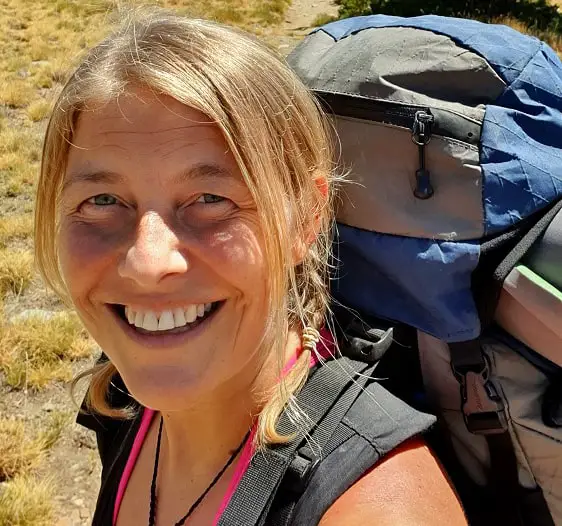
I’m Linn Haglund, the face behind Andalucia Hiking. I’m an avid hiker and after calling Andalucia home for over 10 years, I’ve covered my share of peaks, ravines, rivers, and valleys across all 8 provinces. I’m here to help you navigate this incredible region with thorough hiking guides, hiking tips, and gear recommendations.
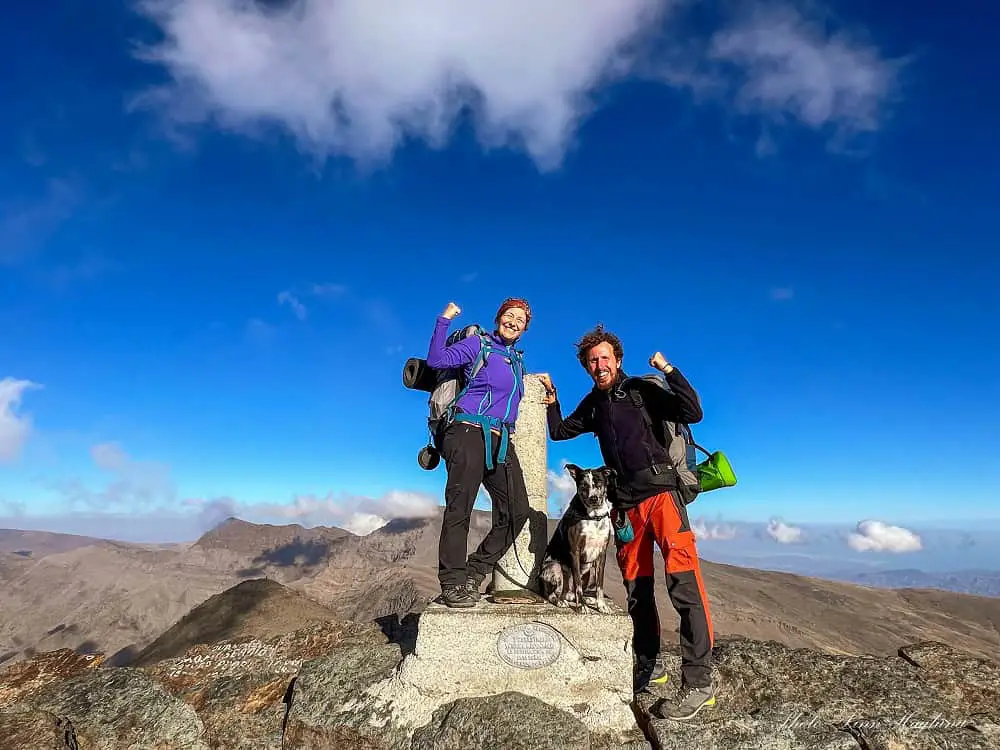
Table of Contents
Practical information
- Province: Granada
- Mountain range: Sierra Nevada
- Length: 10-12 kilometers (by cutting across the main road on the hiking trails)
- Time: 4-6 hours
- Altitude: 3398 masl
- Elevation: 898
- Route: Linear return
- Difficulty: Moderate
- Hiking with dogs: Hiking with dogs is possible here, but they need to be on a leash at all times as you’re in the National Park. There are no natural water sources, so bring enough water for your dog. Be cautious, as you’ll walk on rough terrain with gravel and loose rocks which can hurt your dog’s paws. Bring dog boots if you can or at least make sure you have rubbed the paws in ointment before the hike and after. Baby Atlas had no issues, but my last dog, Ayla would probably struggle with sore paws in her last few years.
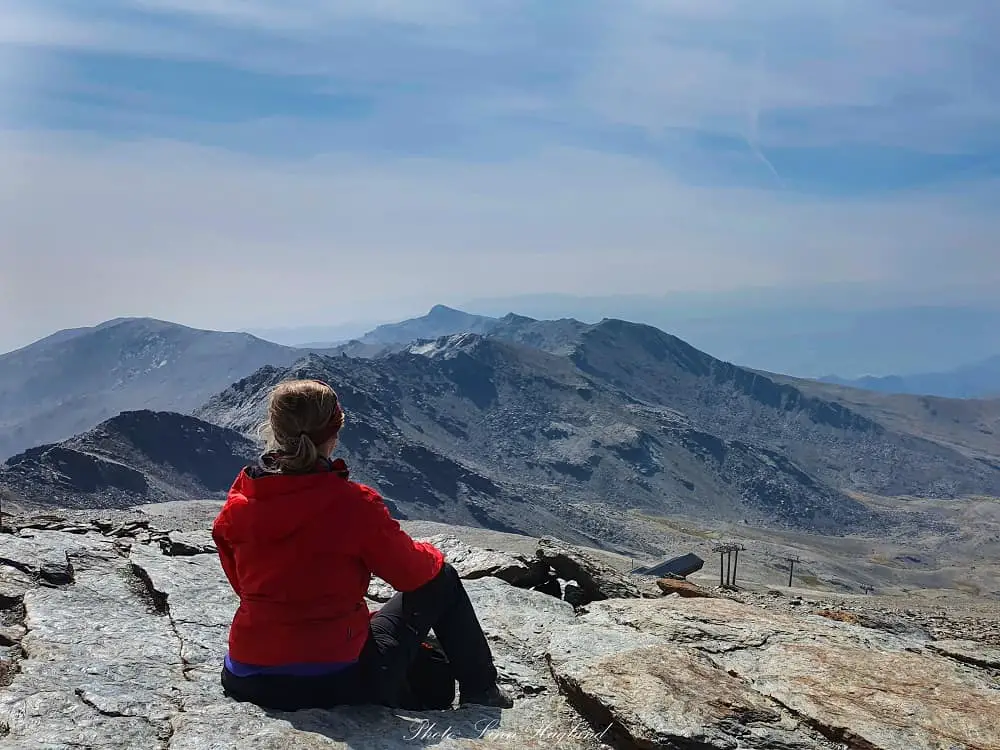
How to get to Pico de Veleta
The trailhead starts at Hoya de la Mora, at an altitude of 2500 meters. You can easily drive there or take the bus. I’ll get into detail here.
By car
By putting Hoya de la Mora into your GPS, it will easily take you there, following the signs to Granada, Sierra Nevada, and continue up the steep hairpin roads, accompanied by astounding views towards Hoya de la Mora.
From Granada, it’s about a 50-minute drive, and from Pradpllano, it’s only 12 minutes.
Once you get there, you’ll find a little tourist area with a guest house and several serving facilities by a big parking lot with free parking.

By bus
There is one bus from Granada to Hoya de la Mora in the hiking season, May to November run by Tocino. It takes around 50 minutes and stops by Pradollano on the way.
It leaves at 08:00 in the morning and returns at 17:15 in the evening. This gives more than enough time to have breakfast at Hoya de la Mora and hike up Pico de Veleta before the bus returns. Check bus tables here.
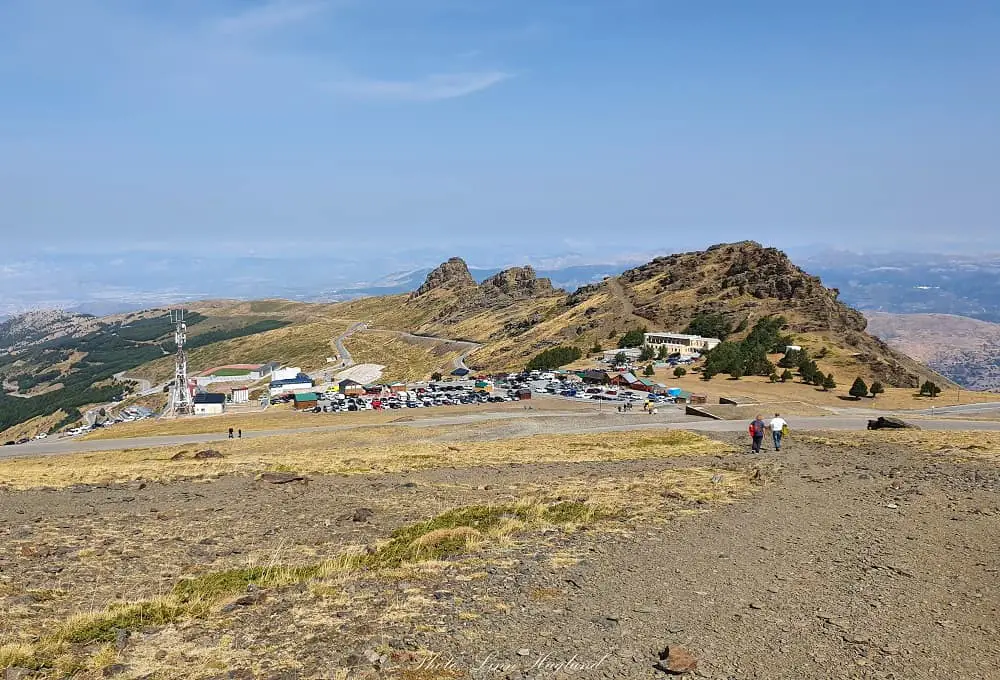
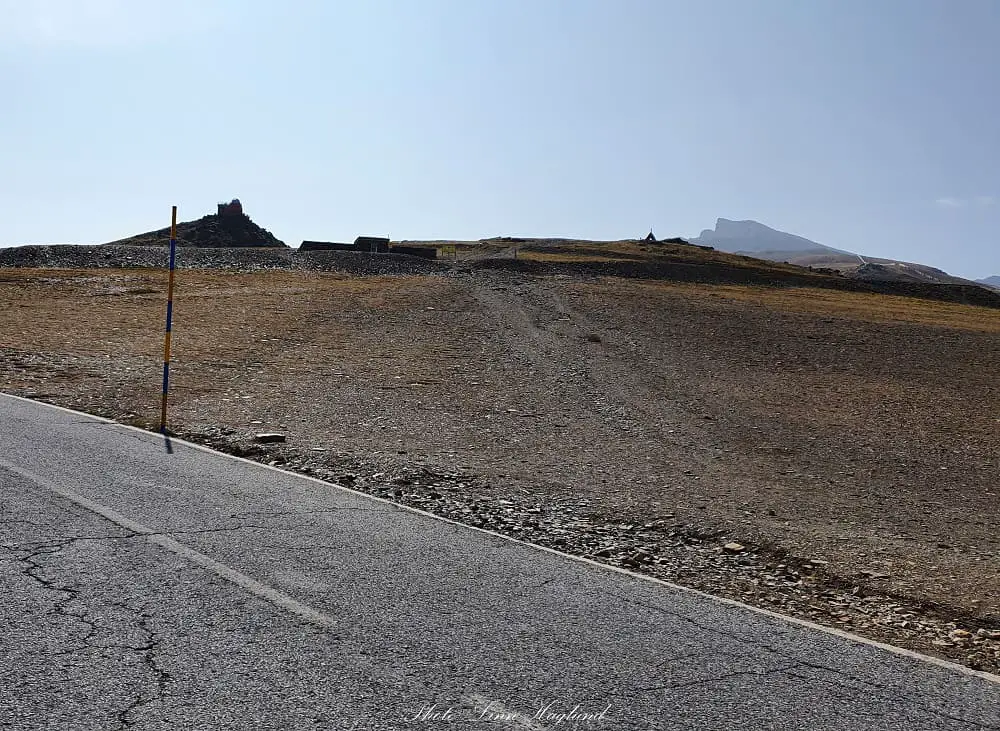
What to bring
The hike from Hoya de la Mora is a highly exposed hiking route to both sun and wind. There is pretty much no shelter for either during the whole trail.
This means you need to be well prepared for both. Even though the sun is shining, you’re at a high altitude, which means the high wind can make it extremely cold. But you might also find yourself hiking in extreme heat.
You can easily start your trek with shorts and a t-shirt on a warm day, but you must have warmer layers in your backpack to put on if needed.
Therefore, make sure you have a well-packed day pack so you’re prepared for it all. You can also see my top hiking gadgets and gear in this post.
Unless you follow the road all the way, trekking poles can be of great support on this hike too. Read my guide here.
Here are the must-haves for your hike:
- caps/hat
- sunscreen
- long pants (you can wear shorts if hot, but bring change)
- fleece
- neck gaiter
- gloves
- knee brace (if you struggle with your knees)
- wind jacket
- water bottle or hydration back (there are no water streams on this hike so you need to bring enough water)
- lunch
- snack (fruit, nuts, energy bars etc)
- camera
Find the best knee braces for hiking here

Can you get altitude sickness during your Veleta hike?
Chances are very small, but you could notice symptoms of altitude sickness getting closer to the top because of its high altitude. With any of the below symptoms, turn around to a lower altitude and ask for help if symptoms get worse.
Make sure you drink lots of water, eat snacks regularly, and cover your head for the sun, so you don’t trigger symptoms because of dehydration or lack of energy. You don’t want to mistake it for altitude sickness or vice versa.
A good tip is to walk slowly the higher up you get so you don’t pressure your body too much.
Look up for the following signs of altitude sickness:
- headache
- dizziness
- tiredness
- shortness of breath

Where to stay when hiking Pico de Veleta
Pradollano
The most comfortable place to stay when hiking Pico de Veleta is Pradollano, the village of Sierra Nevada, as it’s very close and can easily be used as a base for many of the best hikes in Sierra Nevada.
Where to stay in Pradollano
Hotel Kenia Nevada – Excellent hotel in the village. There’s paid parking nearby or you can park on the street. I loved the interior with its wooden beam ceilings and our room had amazing views. The indoor pool and spa is also fantastic.
Meliá Sol y Nieve – Also a very nice hotel with modern interior and great views. There is a spa and indoor pools and if you come by car, you can park for a fee in the hotels parking garage or look for free parking in the streets.

Granada
If you want to balance your hiking adventure with culture and Andalusian history, Granada is the place for you to stay.
With the Alhambra attracting travelers from all over the world, the old town has an impeccable charm and should not be missed when in the area.
I also like staying in Granada if I want a larger variety of restaurants and bars after my hike, so that’s also something to consider.
Where to stay in Granada
LUXURY: Alhambra Palace Hotel – If you’re looking for the ultimate luxury, this is a fantastic choice. Since the hotel opened in 1910, many kings and queens have slept there and when you enter the Arabian style hotel, you’ll understand why it’s so sought after.
MID-RANGE: Palacete 1620 – Set in a 17th-century palace, this is a wonderful hotel with a central patio with fountains and pot plants. They offer studios and apartments which are great if you like to cook in.
BUDGET: Casa del Capitel Nazarí – A lovely hotel set in a 16th century palace with wooden beam ceilings and a Moorish-style central patio. The rooms are modern but have an elegant touch of Arab styled details.
Hiking Pico de Veleta
Tip! Use the toilets at Albergue Universitario de Sierra Nevada (Yellow building by the parking lot) before you start your hike. It’s the only toilet there and there aren’t many places to hide during the hike. You need to buy something in the bar to use it.
Hiking Pico de Veleta from Hoya de la Mora is not a demanding hike and you see people in most ages take in the challenge. However, it is an endurance challenge and requires that you’ve got a basic fitness level.
Most of the hike can be done on the asphalted hairpin road. But this isn’t the nicest, nor the fastest option. Most hikers walk straight up the hiking trail that cuts through the curvy road. Steeper, for sure, but you save quite a few kilometers and don’t have to worry about the shuttle bus running you down or the high numbers of cyclists darting down at frighteningly high speeds.
And let’s be honest, we hikers love to walk on trails and not roads. Am I right?
After the first 10-15 minutes of walking from the car park, you reach the monument of Virgen de las Nieves. This is a popular attraction for tourists and families, but from there, mainly hikers continue the adventure.
Follow the trail straight up. At the first crossing of the paved road, there are two paths you can continue on.
They both lead to the same place, so it doesn’t matter which one you choose. I’ve walked both and can’t say I favor one over the other.
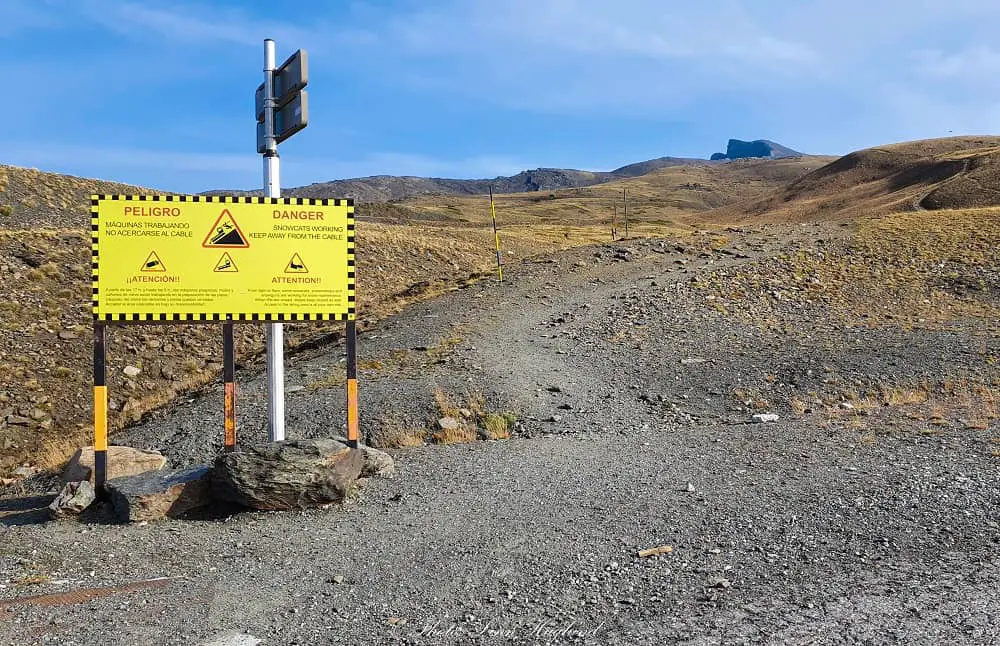
You see the iconic peak with the vertical drop on the left leading the way, that’s Pico de Veleta. You might swap between following the trail and the road a few places as you go, there is no right or wrong.
If you get tired by the steeper trail further up, you can easily relax your muscles by walking on the road until the next place the path crosses it.
Towards the last bit of the trail, there’s quite a bit of scrambling and it gets a lot steeper. If you get worried seeing more than one path going up, don’t worry, as they all lead to the same peak.
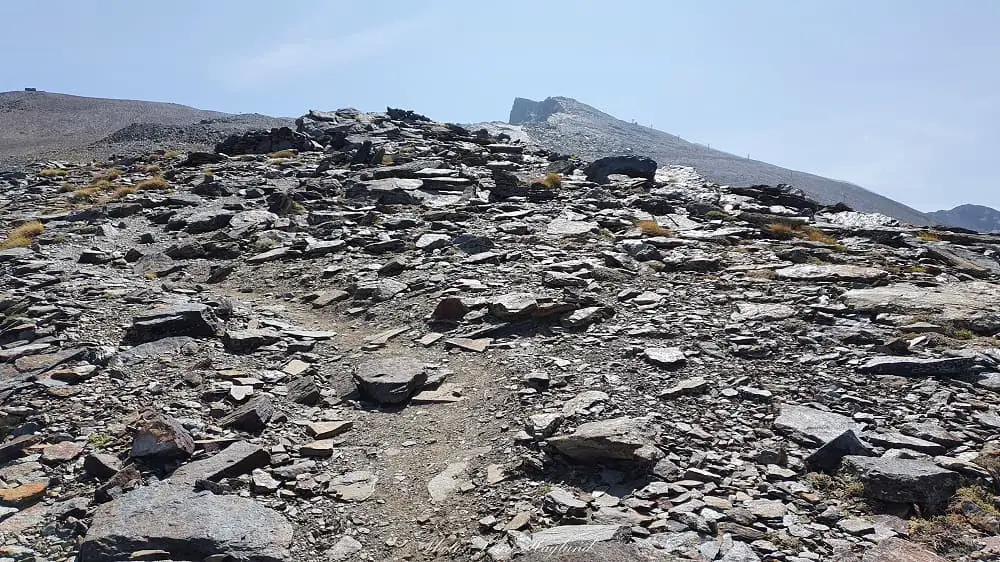
Reaching Pico Veleta
The last scrambling from the top of the chair lift can feel quite hard. Not only is it steep and rocky, but you’re getting at a high altitude. You can walk most of it on a dirt road but it will be longer.
Once at the top, you can relax with mesmerizing views over stunningly attractive mountain peaks on three sides, and Granada and the Mediterranean on one side. On a clear day, you can actually see all the way to Africa. That’s pretty amazing!
You could almost say you’re on top of Spain, but that would be if you hike 2.5-3 hours ahead to Mulhacen, which you can see a bit further ahead beautifully surrounded by other peaks, yet another great Granada hiking adventure.
Hiking the two peaks, is perfectly doable either as a long and hard day trip, starting very early, or as an overnight trip sleeping in the Refugio-Vivac de la Caldera (3065 masl).

Other options for reaching Pico de Veleta
Chair lift
From mid-July to the beginning of September, it’s possible to take the chair lift from Sierra Nevada up to 2900 meters of altitude.
From there it’s only the last scramble up to the top. This is especially popular with families with younger children who can’t walk for that long.
Chairlifts open at 09:45 in the morning and the last one goes at 17:45. However, the last descent is at 18:00, so unless you plan to walk down, I recommend you don’t go any later than 15:30 if you want to walk leisurely up to the peak and stay there a bit before walking down.
Micro bus
There is a microbus that can take you from Albergue Universitario at Hoya de la Mora, up one of Europe’s highest paved roads, almost up to Pico Veleta. It drops you off only a short walk to the top of the peak.
This is the only vehicle allowed to drive in the national park above Hoya de la Mora (except emergency vehicles and park authority vehicles) and is served by Sierra Nevada National Park.
I recommend you book in advance, as the seats fill up quickly. They run between June and October, 08:00-18:00. You can find updated contact information for booking the bus here.
Other hiking routes to Pico de Veleta
The route described in this post is the easiest hiking route from Hoya de la Mora to Pico Veleta. But there are a few other alternatives if you’re looking for a more challenging outdoor experience.
I have not done any of them as they include pitches and require climbing gear. If you want to do either of these and don’t have the necessary skills and gear, make sure you look for a certified guide to do the hike.
North Couloir: Includes abseiling on the north ridge and the path is extremely steep and narrow as it follows the mountainside. It requires some scrambling or even climbing the last bit and can get iced.
Olmedo: Rises from the end of the North couloir, requires climbing, and can be iced.
Fidel-Fierro: Involves climbing and scrambling the last bit on the southern face.
Silvia: Another rocky route that requires climbing with 5 rope pitches on the north cliffs and westwards.
If you choose to combine Veleta with other nearby peaks like Mulhacen, you can stay in one of the free or paid refuges or wild camp along the way.

OTHER HIKES IN SIERRA NEVADA
- Mulhacen
- Ruta de Los Cahorros
- El Chullo
- Rio Molinos
- Siete Lagunas
- Cascada del Goterón
- Lavaderos de la Reina
- Vereda de la Estrella
Reflections of Pico de Veleta hike
There is no doubt that hiking Pico de Veleta is a true bucket list experience. It feels pretty good to reach that height on such a short hike and without further difficulties.
However, if you suffer from a “hiker’s knee”, make sure you bring a knee brace. You can find my recommendations here.
Walking up what are the popular ski slopes of Sierra Nevada in the winter months is pretty cool and there are reminders all over the trail.
Make sure you respect nature and don’t leave any rubbish behind. Rule number one in nature, take with you back anything you took with you out there. And pick up if you see other’s rubbish laying around.
And let’s talk toilet paper. I see a lot of toilet paper lying around and it shouldn’t lie around. Bring a rubbish bag where you can put used toilet paper.
I use biodegradable poop bags (that belong to Atlas) since I always have them lying around pockets and backpacks.
On my last hike, I slept at Refugio La Carihuela which is right below Veleta peak, as we were continuing to Mulhacen the day after, and a group of tourists were feeding fox and mountain goat.
Please don’t feed wildlife!
It really disturbs the eco system and it puts the animals in danger too as they stop being afraid of humans (and they should!) There are large signs about this in the shelter, but somehow people don’t see them.
Sierra Nevada definitely has some of the finest hiking trails in Andalucia so do your part so we can look after this beautiful piece of nature.
Happy hiking!


Thank you for the article. Please tell me how high above sea level the chair lift takes out? what does its cost?
Hey! The chairlift takes you up to 2915 meters of altitude. I haven’t taken it myself so not sure what the price is.
Hi
Is the 10-12 Kilometers walk to Piko de valeta one way of up and back down again?
Is it safe to walk in winter – late december / early january
is it straight forward in terms of routes without any shear drops
do buses run between Granada and Hoya de la mora in winter?
Thanks
Hi! 10-12 kilometers is the total of the route there and back. In winter, the trail is full of snow and Sierra Nevada’s skiing slopes go down Pico Veleta so it is not possible to go hiking there. Once the skiing season is over, which could last until April, you can consider going, but be wary of the weather conditions as there might be snow there until early summer.
Thanks for the sharing!
Question: would it snow in early October? If yes, any recommendation for the hiking there?
Hi Stephan, appologies for the late reply, but I’ve been out of office for a couple of months. I assume you’re already there, but no, it normally doesn’t snow before the end of November. Happy hiking!
Hello – Thanks for the informative site! I’m planning to hike on Nov. 5. Will Veleta likely have snow by then? If so, which trails would be best?
Hi Tom, usually, the snow comes around mid-November to the end of November so I think you should be fine. However, with the weather changing dramatically across the country the last few years, I don’t even know what’s normal anymore. I would double check Sierra Nevada’s pages (look for the ski resort) I think they have live web cam on their site for the skiing season. Considering the hike goes up the skiing slopes, you should get your answer there. Good luck and enjoy the hike!